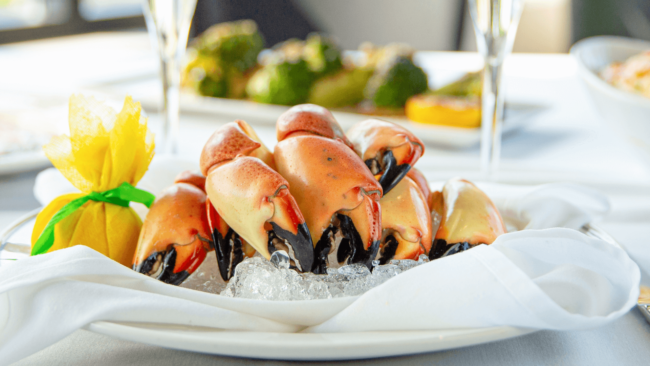When it comes to Florida stone crab, there’s a lot more to love than just that sweet, tender meat. This amazing crustacean species is a marvel of marine biology, sustainability, and flavor — all in one claw. At Truluck’s, we take pride in serving only the freshest, never-frozen Florida stone crab claws, responsibly harvested from the Florida Gulf & Atlantic coasts fresh from our crabbers traps.
Let’s dig into some Florida stone crab facts — the kind of seafood trivia that makes you appreciate every bite even more.
1. Menippe mercenaria facts: The Scientific Name of Florida Stone Crab
Ever heard of Menippe mercenaria? That’s the scientific name for the Florida stone crab, a true local treasure. Two related crustacean species call the southeastern U.S. home: Menippe mercenaria, found across most of Florida, and Menippe adina, living in the northern and western Gulf of Mexico.
These hardy crabs thrive in coastal ecosystems and play a vital role in maintaining balance within the marine ecosystem.
2. 98% of Stone Crabs Come From Florida
Where do Florida stone crabs live? Believe it or not, about 98% of all stone crabs in the U.S. are harvested right here in Florida. That’s huge! We’re lucky to partner with skilled crabbers in Florida who provide us with daily catches of fresh, sustainable Florida stone crab claws — fresh from the traps to our table.
This close partnership supports local communities and ensures sustainable stone crab fishing in Florida remains a long-standing tradition.
3. Stone Crabs Are a Sustainable Source
If you love sustainable seafood, the Florida stone crab is a superstar. Sustainable stone crab fishing in Florida is carefully regulated so that only the claws are harvested, leaving the crab alive to regenerate. The process is similar to how lizards regrow their tails — an incredible feat of claw regeneration.
Stone crabs have two strong claws: one for crushing prey and one for more delicate handling. If a crab loses one, it still uses the other to eat and defend itself until the lost claw grows back.
4. Only the Claws Are Harvested — And There Are Rules
Under Florida stone crab claws harvest rules, only claws that measure at least 2¾ inches from the joint to the tip may be taken. The rest of the crab is released unharmed, ensuring populations stay healthy. These harvesting regulations are vital to protect both the crabs and the ecosystem they support.
That’s one reason stone crab season Florida dates (October 15–May 1) are so strictly enforced. Outside that period, all harvesting stops — giving the crabs time to molt, reproduce, and grow new claws.
5. Female Stone Crabs Can Lay Up to One Million Eggs
Here’s one of the more jaw-dropping Florida stone crab interesting facts: females can produce up to a million eggs in one sitting! Over their lifetime, a single crab may release tens of millions. That reproductive power helps maintain healthy stocks, especially when paired with Florida’s sustainable fishing rules that protect egg-bearing females.
6. How to Catch Florida Stone Crabs
So, how to catch Florida stone crabs? Most crabbers in Florida place baited traps near jetties, oyster reefs, or rocky areas — favorite hangouts for these clever crustaceans.
Once caught, the claws are removed, the crab is returned to the water, and it begins the remarkable process of how stone crab claws regrow Florida-style — slowly, over multiple molts. Claws are sold in four standard sizes: medium, large, jumbo, and colossal.
This hands-on saltwater fishing process demands patience, skill, and respect for the sea.
7. Females Live Longer Than Males
A curious bit of marine biology: female Florida stone crabs generally live longer than males. Females can reach around 8–9 years, while males live closer to 7 or 8. Males usually grow a bit larger, though, with faster but more unpredictable growth rates.
8. Florida Stone Crab Predators and Diet
Wondering about the Florida stone crab predators diet? The top natural threat is the octopus — clever, strong, and able to restrain a crab’s claws with its tentacles before cracking the shell. Other predators include sea turtles, black drum, the Florida horse conch, and of course, us humans.
As for what stone crabs eat — their diet includes oysters, small mollusks, bristle worms, and sometimes seagrass or carrion. Fun fact: if you find a claw with less meat inside, that usually means the crab recently molted or hadn’t eaten much due to stormy water conditions.
9. 350,000 Claws a Season
Each year, Truluck’s captures, prepares, and serves over 350,000 fresh Florida stone crab claws during the stone crab season Florida dates (October 15–May 1). That’s a lot of happy diners — and not a single frozen claw among them.
We take pride in saying the number of frozen Florida stone crab claws we serve is zero. Always fresh, always ethical, always sustainable.
10. Your Table Is Waiting
At Truluck’s, every Florida stone crab claw we serve is a testament to ethical sourcing, harvesting regulations, and deep respect for the marine ecosystem.
We’re proud to support sustainable seafood and crabbers in Florida who make it possible for all of us to enjoy this incredible delicacy — responsibly.
Your table’s waiting. Bring your appetite.



 OCEAN'S FINEST SEAFOOD & CRAB
OCEAN'S FINEST SEAFOOD & CRAB

